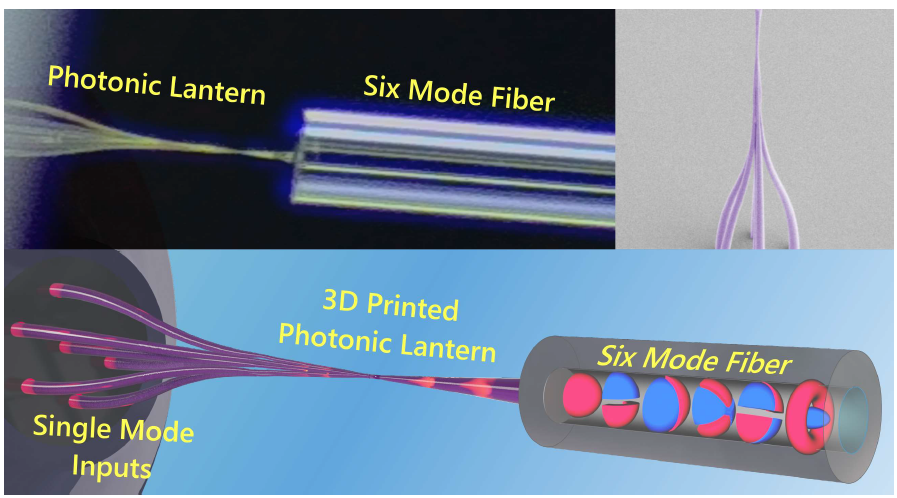
Optical waves propagating through air or multi-mode fiber can be patterned or decomposed using orthogonal spatial modes, with far-ranging applications in imaging, communication, and directed energy. Yet the systems that perform these wavefront manipulations are cumbersome and large, restricting their utilization to high-end applications. The development of a Free-Standing Microscale Photonic Lantern Spatial Mode (De-)Multiplexer using 3D Nanoprinting, as revealed by a recent study, marks a significant advancement in photonic technology. This spatial multiplexer, characterized by its compactness, minimal footprint, and ability to directly print on, and adhere to, photonic circuits, optical fibers, and optoelectronic elements as lasers and photodetectors, opens new opportunities in system integration and adoption of the technology in future high-capacity communication systems and demanding imaging modalities.
New study by Ph.D. candidate student Yoav Dana, supervised by Professor Dan Marom and his team at the Institute of Applied Physics, Hebrew University of Jerusalem, in partnership with scientists from Nokia Bell Labs, resulted in the development and demonstration of a Free-Standing Microscale Photonic Lantern Spatial Mode (De-)Multiplexer. The diminutive photonic lantern was fabricated by a 3D nano-printing technique utilizing direct laser writing, applied directly onto an optical fiber tip.
Photonic lantern devices convert between optical waves containing a superposition of modes or distorted wavefronts and array of separated single mode optical signals. The technology stands out as a promising contender to enable space division multiplexing (SDM) in high-capacity future optical communication networks, as well as in imaging and other applications requiring the spatial manipulation of optical waves.
Harnessing the capabilities of 3D nano-printing and employing high-index contrast waveguides, the researchers have developed a compact and versatile device that can be printed onto nearly any solid platform with fine accuracy and high fidelity, enabling its seamless integration into a variety of technological contexts. The ~100 micrometer scale device stands in large contrast to traditional photonic lanterns based on weakly guiding waveguides that are millimeters-centimeters long, making integration with micro-scale photonic systems very challenging.
“The development of this Free-Standing Microscale Photonic Lantern Spatial Mode (De-)Multiplexer represents a significant advancement in our ability to enable and adopt spatial multiplexing for diverse optical systems and applications,” said Professor Dan Marom. “This breakthrough makes space division multiplexing technology much more accessible and amenable towards integration, opening up new possibilities for optical communication and imaging applications, to name a few.”
The researchers have presented the device design using genetic algorithms, fabrication onto a fiber tip, and characterization of a six-mode mixing, 375µm long photonic lantern capable of converting between six single-mode inputs into a single six-mode waveguide. Despite its compact size, the device exhibits low insertion loss (-2.6 dB), low wavelength sensitivity and low polarization and mode-dependent losses (-0.2 dB and -4.4 dB respectively).
The research paper titled “Free-Standing Microscale Photonic Lantern Spatial Mode (De-) Multiplexer Fabricated using 3D Nanoprinting” is now available in Light: Science and Application and can be accessed at https://doi.org/10.1038/s41377-024-01466-6
Researchers:
Yoav Dana1, Yehudit Garcia1, Aleksei Kukin1, Lauren Dallachiesa2, Sterenn Guerrier2, Nicolas K Fontaine2, and Dan M. Marom1
Institutions:
1) Institute of Applied Physics, Hebrew University of Jerusalem
2) Nokia Bell Labs
Acknowledgements: This work was funded in part by the Israel Innovation Authority via the VCSEL Consortium. The 3D-nanoprinting was carried out at the Peter Brojde Laboratory for Miniature Integrated Systems at the Institute for Applied Physics at the Hebrew University.
Pictures
Title: 3D Nano-Printed Photonic Lantern Mode Multiplexer | Credit: Yoav Dana
Description: A diminutive 3D nano-printed photonic lantern supporting multiplexing of six input sources to a six-mode optical fiber is demonstrated, at 375μm total length, exhibiting low insertion, polarization and mode-dependent loss.

Title: Micro-scale, 3D-printed photonic lantern supporting the conversion between six spatially distinct inputs and six spatially-overlapping orthogonal modes.
Description: The photonic lantern is engineered to losslessly convert between optical sources and modes by optimizing the converging waveguide structure using adaptive learning algorithms and optical simulations. The structure is then printed onto a multi-core fiber source using direct laser writing and two-photon polymerization techniques. Left: Fiber-tip view of ceramic ferule with embedded multi-core fiber, with 300 micron tall, 3D printed photonic lantern on tip. Right: Magnified microscope view of photonic lantern.
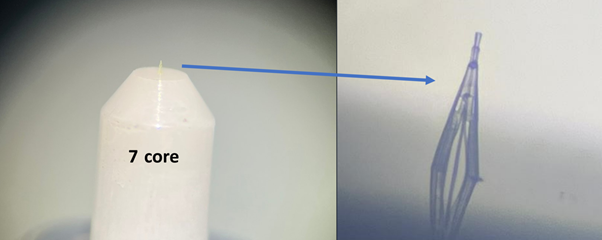
Title: Image of fiber connector tip, with diminutive photonic lantern printed directly onto the fiber facet.
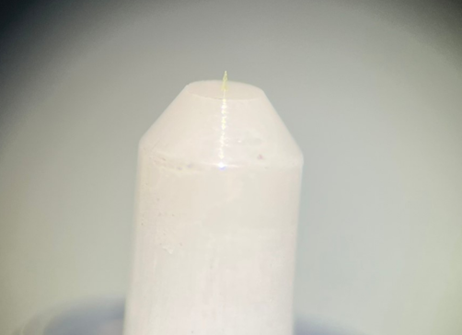
Title: Microscope view of 3D-nanoprinted photonic lantern, with total height of 375 m and spatial features in the 1 m range.
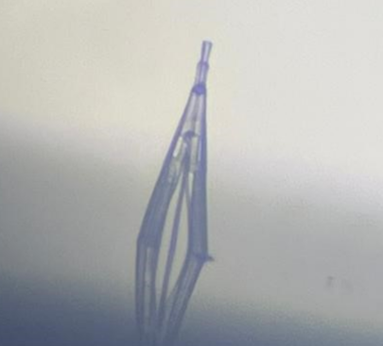
Title: Efficient Interfacing between six optical fiber cores and a six-mode optical fiber with the micro-scale, 3D-printed photonic lantern.
Description: Experimental arrangement for conversion between individual cores and fiber modes with the photonic lantern. The photonic lantern is terminated with an increasing taper to match between the photonic lantern modes and the optical fiber modes placed directly at its output. The optical fiber is then brought to place and coupling power is maximized with translation stages.
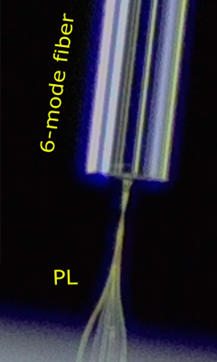
Title: Image of optical fiber disposed directly above photonic lantern for efficiently coupling to the matched 6-mode fiber.
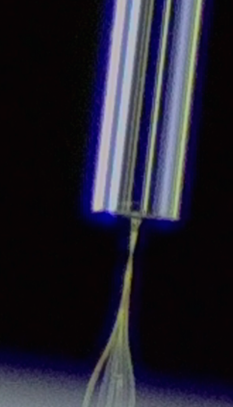
The Hebrew University of Jerusalem is Israel’s premier academic and research institution. Serving over 23,000 students from 80 countries, the University produces nearly 40% of Israel’s civilian scientific research and has received over 11,000 patents. Faculty and alumni of the Hebrew University have won eight Nobel Prizes and a Fields Medal. For more information about the Hebrew University, please visit http://new.huji.ac.il/en.
